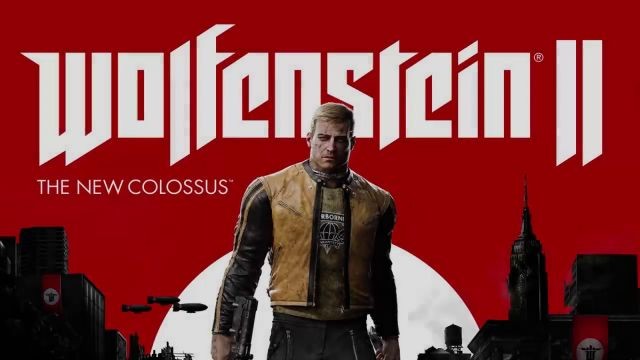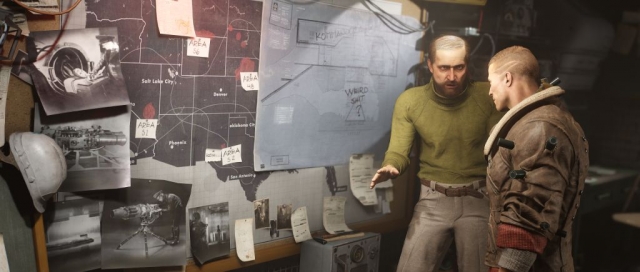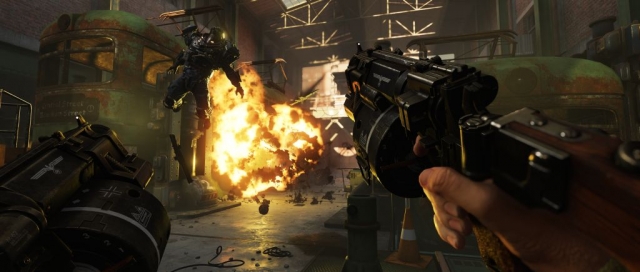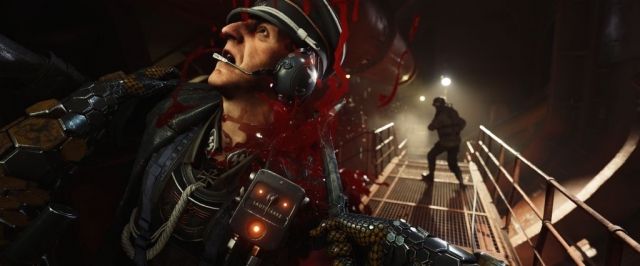Wolfenstein II: The New Colossus

The Good: Nazis. Who doesn’t love killing Nazis? Raucous action, supreme firepower.
The Bad: Occasionally confusing maps, useless in-game map. Endless collectables.
The Ugly: Uneven marriage of FPS and cinematic heart-wrenching drama.
I’ll admit that I’m of somewhat mixed feelings about Wolfenstein II: The New Colossus. The FPS action remains as solid as ever, even if lacking anything really new or groundbreaking, with heavy firepower, satisfying explosions and enemies, and for the most part well-designed levels. However added into this is a story filled with explorations, and somewhat lengthy movies, into B.J. Blazkowicz as a character – who is he, how does he feel about his life, his love, and the sacrifices he has made for his country? The result is a narrative every bit as poignant and heartstring-tugging as the “No Time Left” episode of Telltale Games’ The Walking Dead or Life is Strange. This amalgam of blowing Nazis to pieces and B.J getting angsty about the fate of his unborn twins is, hmmm, uneven. Some parts of the game flow rather organically from action to storyline and back again, but some insertions seem hamfisted of the sort ‘you just shot some Nazis, and now take a moment to feel sad that B.J.’s dad made him shoot his dog over some small childhood infraction (frankly a scene I could have done without) and then you can go back to killing more Nazis. Taken as a whole I feel like it mostly works, but for those hoping for some crazed nonstop adrenaline slaughterfest, which is how I recall Wolfenstein: The New Order, you’re likely to get a lot more ennui and long movies than you were perhaps looking for. And people who go for Life is Strange and that kind of thing for the emotional impact of the story will possibly find themselves unsettled by the twitch and highly gory nature of the gunplay. I myself enjoy both realms, but I think that’s a kind of rare combination in a gamer.
From his modest beginnings as a faceless Nazi killing machine, B.J. has matured and deepened into something far more than a hyper-violent cartoon character. Events in The New Blood have left B.J. broken in body and spirit. Now he is a man dogged by his unfulfilled dreams and fears and regrets, and confined to a wheelchair (more on that in a moment). The first question that immediately came to my mind is, do I need this? There are those who say that Pierce Brosnan brought a more layered approach to the role of James Bond by painting a character who, despite being James Bond, is nonetheless assailed by doubts and haunted by questions of what he has sacrificed so much of his life for, and all of that isn’t what audiences go and see James Bond for. They go to see the consummate spy, a man unencumbered by either regrets or erectile dysfunction (B.J. suffers from both, which his somewhat ironic given his initials B.J.). I might argue that’s the same tone of B.J. Blazkowicz I’m looking for. Regardless, the movies are first rate, mixing excellent voice acting and a nice balance of humor among the sadness to keep the former from becoming overwhelming (on Main Street, stick around and watch a Nazi soldier try and teach two Kluckers to speak German – priceless!). Also in the story is more than a dash of commentary about what America might look like as a totalitarian state – not Robocop or Starship Troopers level of satire, but respectable. I’ll make no observations about any possible parallels to America’s present political climate.
Where many recent FPS games have been experimenting with changes to the underlying FPS formula (I’m thinking here specifically of Doom and Dishonored), Wolfenstein II: The New Colossus has more or less stayed with the horse that brung them, lifting most of the gameplay directly from The New Order. What explorations they have made, like placing B.J. Blazkowicz in a wheelchair, occur for only short periods of time, and so feel more gimmicky than anything else. Early press in particular made a lot of mention of the wheelchair sections, which, if you play rapidly, might last all of half an hour. Late in the game they also add some new mechanics such as stilts (yes, stilts, which turn out to be pretty cool actually), but they come far too late to the game to really give you an opportunity to experiment with them. I would argue that if you’re going to add some dramatically new game mechanic, go with it; add it in and stick with it and let the gamers go nuts. As done here, piecemeal, early and only for a short time, or so late it hardly matters – it feels like a tease. That said, the bones of what they started with remain sound, and there’s perhaps no particular reason to mess with the many good things they already had going for them. Areas have a commander who will call in reinforcements (quite a few reinforcements) if you are discovered, so there is a good reason to try and get to that person without sounding an alarm, plus it gives you a chance to experience the incredibly violent instakill you commit with a fire axe when killing silently. However, as in the last game, the stealth mechanic remains a little unforgiving, so levels are almost guaranteed to morph into a firefight at some point. I personally like this balance of trying a little stealth, then going full bore at some point. Maps offer many ways around to your objective even as they are loaded with the usual FPS tropes of ventilation ducts and steam accesses, but there they are, and it can be a little tricky to find yourself a safe corner in which to make a stand when the enemy reinforcements show up. On the topic of maps I’ll also add that I got lost, A LOT. Part of this is that if you can get to your objective in several ways, you can also find yourself wandering in circles if the scenery isn’t very distinct. The submarine from The New Order makes a reappearance in this installment as your base of operations, and it’s all pipes and catwalks and crawlspaces, and the in-game map is damned near useless, and the game claims to give you hints as to where you should be going, but tells you nothing. “Go see Set in his lab” is my goal, and the hint is “Go see Set,” and I’m climbing some anonymous steel ladder wondering if it is a new ladder, or the same on I’ve already climbed 5 times. In bombed out Manhattan, I’m asking myself if that is a new destroyed building I need to search, or one I’ve been through already. There is a lot of that going on.
You can wield weapons in both hands, different weapons if you so choose, giving you a truly awesome level of firepower when called for. Early in the game you are asked to revisit the moral choice of who you save: Wyatt or Fergus – I chose Fergus as I had the last time – which leads to a bunch of different movies and dialog, but also gives you access to an energy shotgun that literally blows Nazis into wisps of glowing embers. I freaking love this gun (saving Wyatt gets you a gun that lobs bombs which wasn’t nearly as great). Added in are weapon upgrade kits scattered around that you can apply to any weapon, though the upgrades that are available for any weapon are fixed – that aforementioned energy shotgun only has three upgrades available: increased magazine storage, a scope, and a charged shot – and you can only put one upgrade into each, so it’s not like you can add fourteen levels of upgrade to the charged shot and magazine size and carry around an uberweapon. The game also lets you carry as many weapons as you like at one time, with the exception of heavy weapons which not only slow you down but also are only carried in your hands; if you try and swap them for another gun in your inventory, you end up dropping the heavy weapon. While I’m at it I’ll add that you can gain levels in some weapons, like heavy weapons, and skills, like killing silently. It probably makes you marginally better with those weapons or at those skills, but I’ll say that it isn’t immediately obvious that it does so. If you’re getting better, you’re certainly not getting dramatically better with each level.
The game is heaped full of collectables. I’m not a collectables guy and see no point in trying to find every last star card (whatever the heck they are, and I’ve even collected a bunch of them), or gold bar or other assorted bric-a-brac. And the game doesn’t penalize me for ignoring it all. My only complaint is that mixed in among all of the stuff that I have no interest in picking up is stuff that I do want to pick up (ammo, armor, weapons, weapon upgrade kits). Even without reading it over, I recall in my review of The New Order lamenting that you had to point, somewhat fiddly, at a thing and hit a key to pick up anything in the game, instead of just picking up, say, ammunition by running over it. That remains true here as well.
I’m torn between calling Wolfenstein II: The New Colossus brave or merely unexpected. The core of The New Colossus remains as good as, and largely unchanged from, the earlier game. It’s great, explosive, and violent. The other half, so to speak, the heavy emphasis on story doesn’t drive the FPS experience so much as shift your focus into directions that FPS games don’t normally go. That’s not to say that FPS games don’t tell a story or even a complex story (Bioshock told an incredibly involved story and even explored the extrapolation of a Randian economics as a political movement), but they rarely (AFAIK never) attempt to tell a story so full of sadness and self-examination. The two parts sometimes fit well, sometimes less than well, and I think individual gamers will react very differently to the result.
Reviewed By: Phil Soletsky
Publisher: Bethesda Softworks
Rating: 80%
——————————————————————————–
This review is based on a digital copy of Wolfenstein II: The New Colossus for the PC provided by Bethesda Softworks.
 Game Over Online
Game Over Online










What a pile